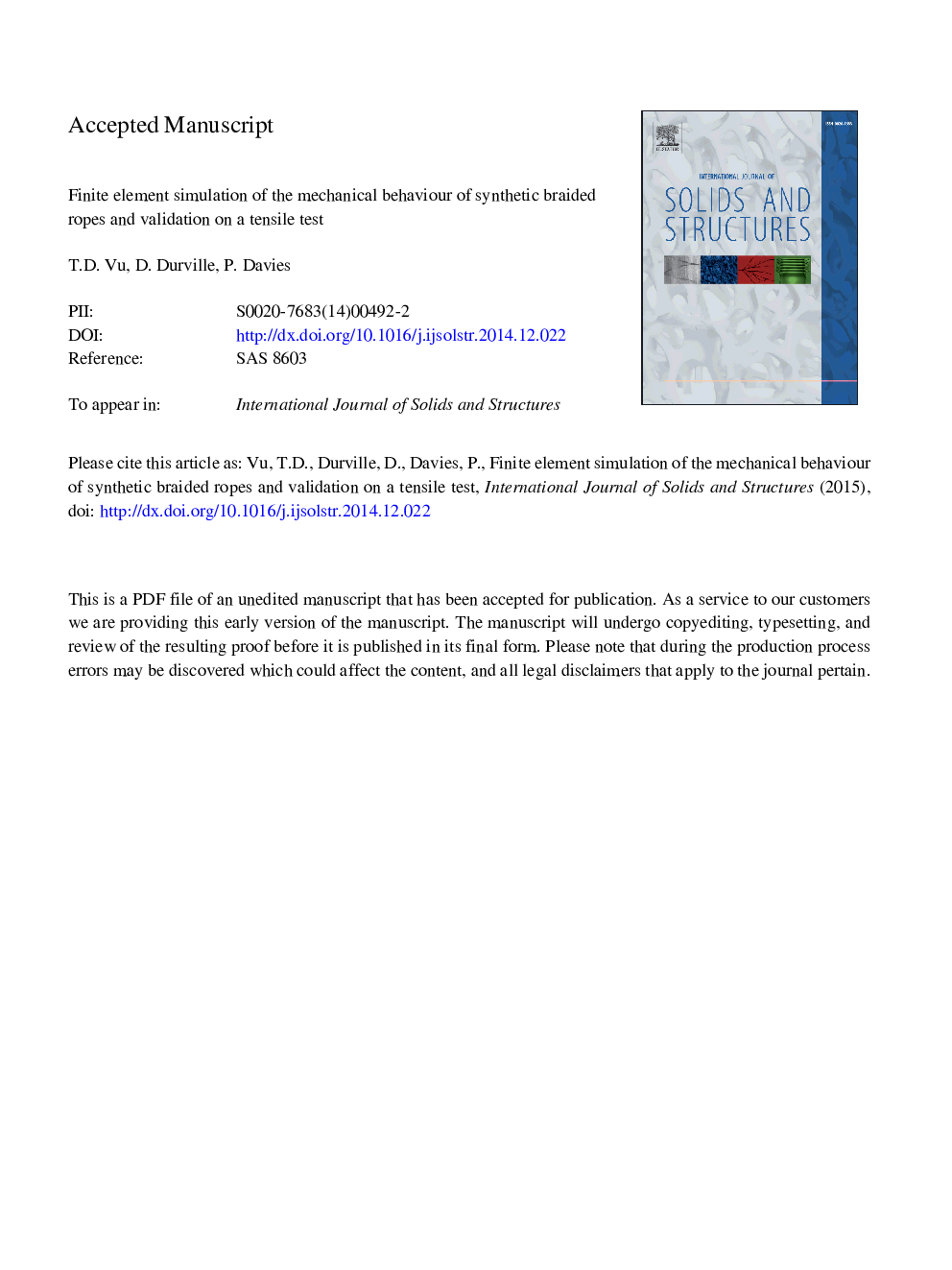| کد مقاله | کد نشریه | سال انتشار | مقاله انگلیسی | نسخه تمام متن |
|---|---|---|---|---|
| 6748940 | 1430225 | 2015 | 39 صفحه PDF | دانلود رایگان |
عنوان انگلیسی مقاله ISI
Finite element simulation of the mechanical behavior of synthetic braided ropes and validation on a tensile test
ترجمه فارسی عنوان
شبیه سازی عنصر محدود از رفتار مکانیکی طناب بافته مصنوعی و اعتبار سنجی بر روی آزمون کششی
دانلود مقاله + سفارش ترجمه
دانلود مقاله ISI انگلیسی
رایگان برای ایرانیان
کلمات کلیدی
طناب بافته شده شبیه سازی عنصر محدود، تماس با اصطکاک سازه های نساجی، خواص کششی،
ترجمه چکیده
در این مقاله یک رویکرد عددی محدود به رفتار مکانیکی طناب بافته شده در مقیاس اجزای داخلی آن ارائه شده است. طناب ها در نظر گرفته شده از ده ها تن از الیاف نساجی تشکیل شده اند که در رشته ها پیچ خورده اند و سپس با هم پوشانده می شوند. هدف این روش تعیین تعادل مکانیکی چنین سازه هایی است، به عنوان مجموعه ای از نخ هایی که در معرض جابجایی های بزرگ قرار می گیرند و در تعاملات تماس های اصطکاک ایجاد می شود. برای حل این تعادل در یک چارچوب شبه استاتیک و با استفاده از یک راه حل ضمنی، هر نخ از طناب با یک مدل پرتو کششی محدود نشان داده شده است و تاکید ویژه بر تشخیص و مدل سازی تعاملات تماس اصطکاک بین نخ ها است. این رویکرد ابتدا برای تعیین پیکربندی ناشناخته اولیه طناب استفاده می شود، که از یک پیکربندی دلخواه و با استفاده از تعاملات تماس با اطلاعات از الگوی بریده انتخاب شده، برای تعیین ساختار بافته به عنوان راه حل یک تعادل مکانیکی استفاده می شود. مقایسه ها با داده های تجربی در این هندسه اولیه ساخته می شوند. آزمایشات آزمون کششی برای مشخص کردن پاسخ مکانیکی هر دو نخ ریسی و طناب بافته شده انجام شد. این آزمایش ها با مدل شبیه سازی شده و نتایج با آزمایش مقایسه می شود. تجزیه و تحلیل حساسیت بر روی پارامترهای طراحی نشان دهنده توانایی های مدل گزارش شده است.
موضوعات مرتبط
مهندسی و علوم پایه
سایر رشته های مهندسی
مهندسی عمران و سازه
چکیده انگلیسی
A finite element approach to the mechanical behavior of braided ropes at the scale of their internal components is proposed in this paper. The ropes considered are composed of a few tens of textile yarns, twisted into strands, which are then braided together. The approach aims at determining the mechanical equilibrium of such structures, viewed as assemblies of yarns undergoing large displacements and developing contact-friction interactions. To solve this equilibrium within a quasi-static framework, and using an implicit solution scheme, each yarn of the rope is represented by a finite strain beam model, and special emphasis is put on the detection and modeling of contact-friction interactions between yarns. The approach is used first to determine the unknown initial configuration of the rope, starting from an arbitrary configuration and using contact interactions together with information from the selected braid pattern, to determine the braided structure as the solution of a mechanical equilibrium. Comparisons are made with experimental data on this initial geometry. Tensile test experiments were performed to characterize the mechanical response of both the elementary yarns and the braided rope. These tests were simulated with the model, and results are compared with experiment. Sensitivity analyses on design parameters showing the abilities of the model are reported.
ناشر
Database: Elsevier - ScienceDirect (ساینس دایرکت)
Journal: International Journal of Solids and Structures - Volume 58, April 2015, Pages 106-116
Journal: International Journal of Solids and Structures - Volume 58, April 2015, Pages 106-116
نویسندگان
T.D. Vu, D. Durville, P. Davies,
